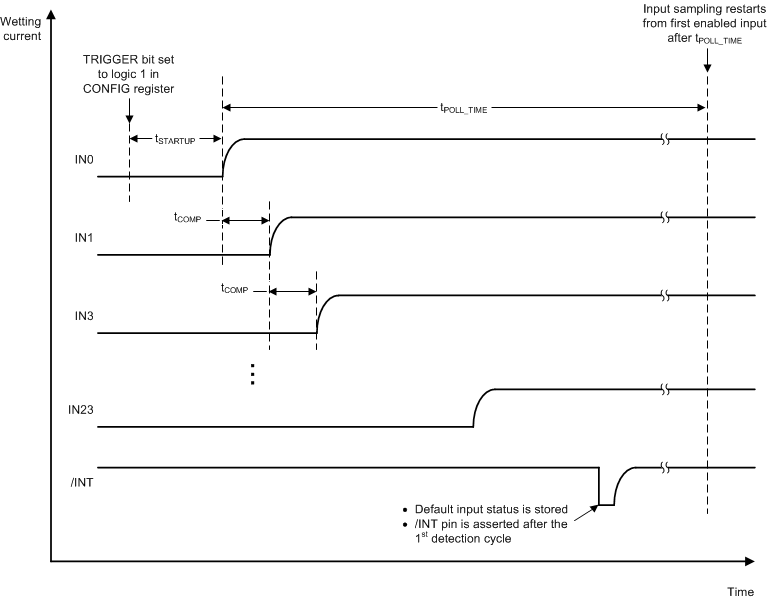SCPS268A September 2017 – February 2022 TIC10024-Q1
PRODUCTION DATA
- 1 Features
- 2 Applications
- 3 Description
- 4 Revision History
- 5 Pin Configuration and Functions
- 6 Specifications
- 7 Parameter Measurement Information
-
8 Detailed Description
- 8.1 Overview
- 8.2 Functional Block Diagram
- 8.3
Feature Description
- 8.3.1 VS Pin
- 8.3.2 VDD Pin
- 8.3.3 Device Initialization
- 8.3.4 Device Trigger
- 8.3.5 Device Reset
- 8.3.6 VS Under-Voltage (UV) Condition
- 8.3.7 VS Over-Voltage (OV) Condition
- 8.3.8 Switch Inputs Settings
- 8.3.9 Interrupt Generation and INT Assertion
- 8.3.10 Temperature Monitor
- 8.3.11 Parity Check And Parity Generation
- 8.3.12 Cyclic Redundancy Check (CRC)
- 8.4 Device Functional Modes
- 9 Programming
- 10Application and Implementation
- 11Power Supply Recommendations
- 12Layout
- 13Device and Documentation Support
- 14Mechanical, Packaging, and Orderable Information
Package Options
Mechanical Data (Package|Pins)
- DCP|38
Thermal pad, mechanical data (Package|Pins)
- DCP|38
Orderable Information
8.4.1 Continuous Mode
In continuous mode, wetting current is continuously applied to each enabled input channel, and the status of each channel is sampled sequentially (starting from the IN0 to IN23). The TIC10024-Q1 monitors enabled inputs and issues an interrupt (if enabled) if a switch status change event is detected. The wetting current setting for each input can be individually adjusted by configuring the WC_CFG0 and WC_CFG1 to the 0mA, 1mA, 2mA, 5mA, 10mA, or 15mA setting.
Figure 8-11 below illustrates an example of the timing diagram of the detection sequence in continuous mode. After the TRIGGER bit in register CONFIG is set to logic 1, it takes tSTARTUP to activate the wetting current for all enabled inputs. The wetting currents stay on continuously, while each input is routed to the comparator for sampling in a sequential fashion. After detection is done for an input, the switch status (below or above detection threshold) is stored in the register (IN_STAT_COMP) to be used as the default state for subsequent detection cycles. After the end of the first polling cycle, the INT pin is asserted low to notify the microcontroller that the default switch status is ready to be read. The SSC bit in INT_STAT register and the SPI status flag SSC are also asserted to logic 1. The polling cycle time (tPOLL) determines how frequently each input is sampled and can be configured in the register CONFIG.
 Figure 8-11 An Example Of The Detection Sequence In Continuous Mode
Figure 8-11 An Example Of The Detection Sequence In Continuous ModeThe INT_STAT register is cleared and INT pin de-asserted if a SPI READ command is issued to the register. Note the interrupt is always generated after the 1st detection cycle (after the TRIGGER bit in register CONFIG is set to logic 1). In subsequent detection cycles, the interrupt is generated only if switch status change is detected.
No wetting currents are applied to 0mA- configured inputs, although some biasing current (as specified by IIN_LEAK_0mA) may still flow in and out of the input. Threshold crossing monitoring is still performed for the input using the defined threshold(s). The 0mA setting is useful to utilize the integrated comparator to measure applied voltage on a specific input without being affected by the device wetting current.